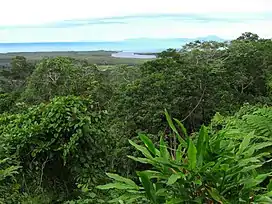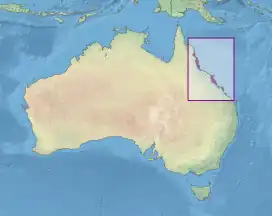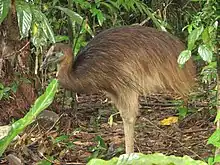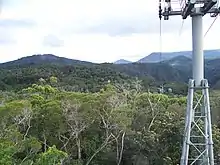| Queensland tropical rain forests | |
|---|---|
 Daintree Rainforest, Queensland | |
 Ecoregion territory (in purple) | |
| Ecology | |
| Realm | Australasian realm |
| Biome | tropical and subtropical moist broadleaf forests |
| Geography | |
| Area | 33,129 km2 (12,791 sq mi) |
| Countries | Australia |
| States | Queensland |
| Coordinates | 21°15′S 148°45′E / 21.25°S 148.75°E |
| Conservation | |
| Conservation status | Vulnerable |
| Global 200 | Queensland tropical rain forests |
| Protected | 3,260 km² (10%)[1] |
The Queensland tropical rain forests ecoregion (WWF ID: AA0117) covers a portion of the coast of Queensland in northeastern Australia and belongs to the Australasian realm. The forest contains the world's best living record of the major stages in the evolutionary history of the world's land plants, including most of the world's relict species of plants from the ancient supercontinent of Gondwana.[2] The history of the evolution of marsupials and songbirds is also well represented.
Location and description
The ecoregion covers 32,700 square kilometers (12,600 sq mi) of northeastern coastal Queensland, from the coast up a series of plateaus and tablelands to the mountains behind the coast. The ecoregion comprises three separate sections.[3] The northern area, which includes Cairns, is the largest, from 15°30’ to 19°25’ south latitude. This northern section is also known as the Wet Tropics bioregion, and is just east of the Einasleigh Uplands.[4] The middle section is centred on Mackay, Queensland, and the southern section is just south of Shoalwater Bay. These latter two sections are bounded on the west by the Brigalow tropical savanna ecoregion. Elevations in the ecoregion rise from sea level to 1,477 metres, with a mean of 301 metres.[3]
Climate
The climate of the ecoregion is a borderline tropical rainforest climate (Af)[5] and Dry-winter humid subtropical climate (Köppen climate classification (Cwa)). The latter climate is characterized as having no month averaging below 0 °C (32 °F), at least one month averaging above 22 °C (72 °F), and four months averaging over 10 °C (50 °F). Precipitation in the wet summer months is ten time or more the average of the winter months.[6][7] In this particular ecoregion, annual precipitation is highly variable, with annual averages between 1,200 and 8,000 mm. The rainy season is November to April.[2]
Flora and fauna
The Queensland tropical rain forests are designated one of the Global 200 ecoregions. The ecoregion is the largest remnant of Australia's rain forest flora, home to ancient assemblage of plants, called the Antarctic flora, presently characteristic of New Zealand and southern Chile. Fossil pollen records indicate closed forest covered most of Australia between 50 and 100 million years ago.[8] These forests represent the closest living remnant of the vegetation type from which all of Australia's unique vegetation developed.[8][9][10] The vegetation remained across Australia and Antarctica until about 15 million years ago.

Currently, about 65% of the ecoregion is closed forest of broadleaf evergreens.[3] Conifers of the southern hemisphere family Araucariaceae are the characteristic tree species. In the northern section of the ecoregion, Kauri commonly form the forest canopy, with Agathis robusta most common at lower elevations, and A. microstachya and A. atropurpurea predominant at higher elevations. In the southern sections, Araucaria cunninghamii is predominant, with Araucaria bidwillii dominant in two small areas. Conifers in the family Podocarpaceae are also present, including genera Podocarpus and Sundacarpus. The forests are thick with vines, ferns, epiphytes, and palms.
These forests are limited to areas of high rainfall and good soils. In waterlogged soils, the rainforest flora gives way to Melaleuca thickets, and on poor soils and in drier areas Eucalyptus becomes dominant. The rainforest flora is intolerant of fire, and where periods of drought have allowed devastating fires, the rainforest flora has retreated, allowing fire-tolerant Eucalyptus to become established. If a relatively wet period persists, the rainforest flora may reestablish itself. It is thought that the land management practices of the aboriginal Australians, which involve setting regular fires to keep the eucalyptus woodlands open, may have encouraged the expansion of eucalyptus forests at the expense of the rainforest flora. These rainforests seem to have retreated considerably since the arrival of the aboriginals' ancestors 50,000 years ago, and are presently limited to isolated pockets comprising less than 2% of the continent's area.

Animal biodiversity is high, also. 672 species of terrestrial vertebrates have been recorded in the ecoregion, 370 species of birds, 70 species of reptile, and 78 species of freshwater fish (of Australia's total of 180 fish species). 11% of the vertebrates are endemic to the region, and 22% of the reptiles. Most of the endemic species live about 400 metres in the rainforest.[2]
Conservation
These forests are particularly interesting because of their southern location and the high degree of endemism of their plant and animal species. Deforestation caused by logging, road building and farming has led to habitat fragmentation[11] and diminishing populations of species such as spotted-tailed quoll (Dasyurus maculatus), cassowary (Casuarius casuarius), and ring-tail possum (Hemibelideus lemuroides). Introduced species also pose a serious threat to many native species.
In an effort to preserve the Daintree Rainforest north of the Daintree River it was decided by the Government of Queensland in 1993 to halt the spread of the electricity network north of that point, providing a limit to tourist development.[12]
Protected areas include the following:
Tourism

The forests, together with the Great Barrier Reef, have been identified and promoted as a major tourist attraction of Tropical North Queensland, one of five within the state.[13] One of the most significant tourist attractions in the rain forests is the Skyrail Rainforest Cableway.
See also
References
- ↑ Eric Dinerstein, David Olson, et al. (2017). An Ecoregion-Based Approach to Protecting Half the Terrestrial Realm, BioScience, Volume 67, Issue 6, June 2017, Pages 534–545; Supplemental material 2 table S1b.
- 1 2 3 "Queensland tropical rain forests". Terrestrial Ecoregions. World Wildlife Fund. Retrieved 2 December 2012.
- 1 2 3 "Queensland tropical rain forests". Digital Observatory for Protected Areas. Retrieved 20 August 2020.
- ↑ "Map of Ecoregions 2017". Resolve, using WWF data. Retrieved 20 August 2020.
- ↑ "Northeastern Australia | Ecoregions | WWF".
- ↑ Kottek, M., J. Grieser, C. Beck, B. Rudolf, and F. Rubel, 2006. "World Map of Koppen-Geiger Climate Classification Updated" (PDF). Gebrüder Borntraeger 2006. Retrieved 14 September 2019.
{{cite web}}: CS1 maint: multiple names: authors list (link) CS1 maint: numeric names: authors list (link) - ↑ "Dataset - Koppen climate classifications". World Bank. Retrieved 14 September 2019.
- 1 2 McDonald, Geoff; Marcus B. Lane (2000). Securing the Wet Tropics?: A Retrospective on Managing Australia's Tropical Rainforests. Federation Press. p. 14. ISBN 1862873496. Retrieved 3 December 2012.
- ↑ Webb, L. J. (Leonard James), 1920-2008; Tracey, J. G. (John Geoffrey), 1920-2004 (1981), Australian Rainforests: Patterns and Change (Ecological Biogeography of Australia, vol. 1 p. 605-694), The Hague: W. Junk, hdl:102.100.100/292256
{{citation}}: CS1 maint: multiple names: authors list (link) CS1 maint: numeric names: authors list (link) - ↑ Sanderson, Rachel (1 May 2008). "Re-writing the History of Australian Tropical Rainforests: 'Alien Invasives' or 'Ancient Indigenes'?". Environment and History. 14 (2): 165–185. doi:10.3197/096734008X303719. JSTOR 20723663.
- ↑ Champion, Neil (2006). Tropical Rain Forests. Black Rabbit Books. p. 18. ISBN 1583405089. Retrieved 2 December 2012.
- ↑ Sharma, K. (2004). Tourism & Economic Development. Sarup & Sons. p. 330. ISBN 8176254967. Retrieved 2 December 2012.
- ↑ Sharma, K. K. (2004). World Tourism Today. Sarup & Sons. p. 172. ISBN 8176255122. Retrieved 2 December 2012.